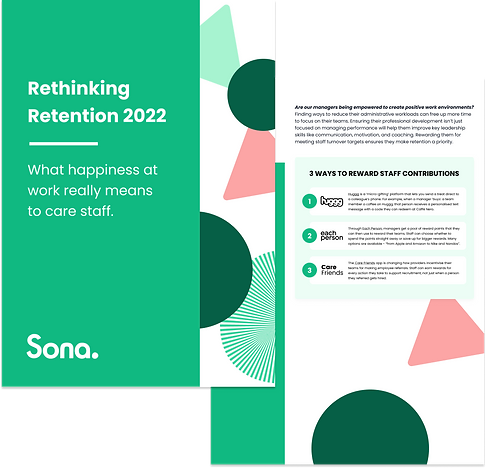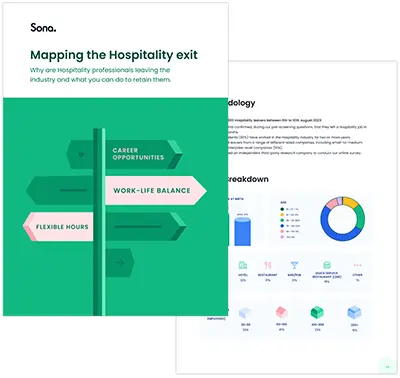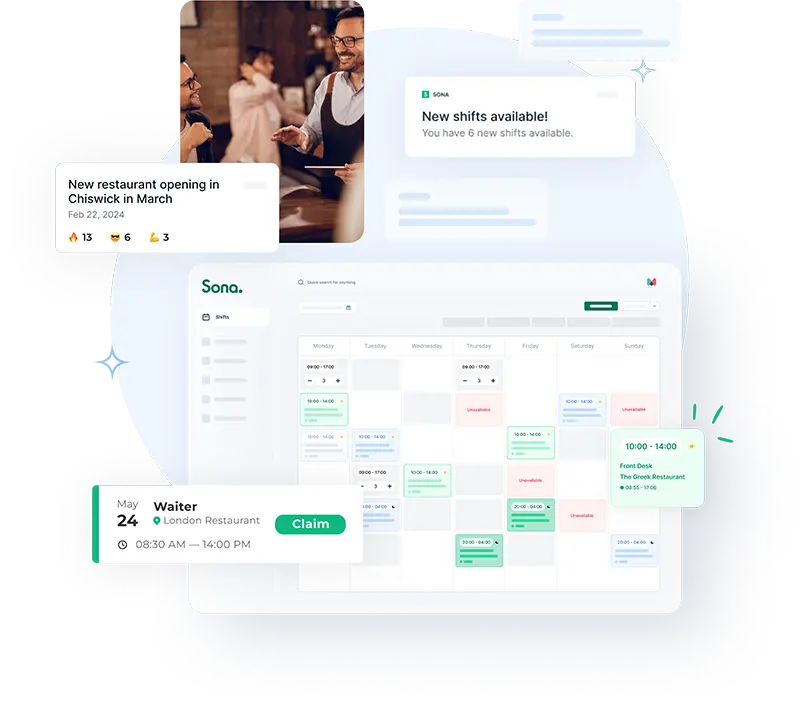New partnership announced with Borderless
Sona and Borderless announce an exciting partnership.
Building a staff schedule couldn’t be easier.
Reduce payroll errors with real-time T&A.
Fill 50% more shifts with your own employees.
Ensure shifts are covered even if you're understaffed.
Manage absence requests and approvals.

Practical ways to boost team morale with proven examples from across the sector.

Find out what care employees say matters to them most at work.
Search and view employees with customised permission levels.
Key employment information all in one place.
Store visas, professional certifications and more with easy access.
Control personal and operational details of your staff.

Why are people leaving Social Care, and where are they going?

We asked 250 Social Care leaders about their attitudes towards digitisation and their plans for the next 12 months...

Why are Hospitality workers leaving the industry, and what can you do to retain them?
Share updates with a single click.

Staff can see relevant messages in one place.
Request post-shift feedback from staff.
Recognise staff contributions by sending them praise.
Identify staff at risk of churning.

How care organisations can embrace flexible working and thrive.
Maintain quality of care and reduce costs.
Maximise profitability through AI-powered forecasting & scheduling.
Elevate your operational efficiency and guest satisfaction.
Streamline operations across sites.
Developed alongside Social Care experts with decades of combined experience.
See why we are the leading user-friendly, end-to-end platform that prioritises both efficiency and wellbeing.
The Sona Partner Network is an ecosystem of solution experts and complementary technologies.

Give staff greater visibility of shifts available to work, with a simple "shift claim" process to increase their income.
Improve employee engagement and retention with a seamless employee communication platform.
Happier staff provide greater customer experiences, which in turn drives return rates, revenues and recommendations.

Give staff greater visibility of shifts available to work, with a simple "shift claim" process to increase their income.
Improve employee engagement and retention with a seamless employee communication platform.
Happier staff provide greater customer experiences, which in turn drives return rates, revenues and recommendations.

Meet the Sona team online with our webinar series or in-person at an event near you.
New research, insights, and strategies for frontline leaders.
Downloadable templates, reports and guides from Sona.
Stay up to date with the latest Sona news and research.
Learn how our customers are transforming their people operations.
| 3 min read
Sona and Borderless announce an exciting partnership.
| 2 min read
Sona and Found by Lottie announce an exciting partnership.
| 4 min read
Remove operational errors, drive efficiency, and help your team spend less time on admin with a unified solution.
PUBLISHED: February 2025
Download the report to learn how hospitality operators are embracing AI challenges and opportunities in 2025.
PUBLISHED: January 2025
Reveal the most important metrics in 2025!
PUBLISHED: December 2024
This infosheet is packed with practical insights to drive high-quality, low-regret WFM purchases.Recruitment and retention is often the first thing on many providers’ list of challenges. According to our 1000-responder poll, Health and Social Care employees aren’t just leaving their organisations, they’re exiting the sector altogether. And yet, there’s good news for recruiters: more than half are willing to return in the right circumstances!
5 minute read
These are boomerang employees. We’re going to explore how to bring them back, what questions to ask them in an interview, and what are the pros and cons of hiring returning employees for your organisation.
Most often, people refer to an employee who leaves an organisation for another, then returns to the first as a boomerang employee. But the term can be expanded for those leaving one sector for a different one, then realising it is not a good fit and going back to their first choice. Fundamentally, returning employees are boomerang employees.
Some care professionals decide to take a chance and look at different careers, with most of them looking for:
In our 2022 exit interview poll, we found that most Social Care employees who were looking at different sectors put “finance and insurance” as the top choice (14%), with retail following closely. In 2023, education has taken the top spot (12%).
 Out of these, it is likely that some might not feel as fulfilled in their new sector and try to return to care work by reaching out to their previous organisations. These would be Social Care boomerang employees.
Out of these, it is likely that some might not feel as fulfilled in their new sector and try to return to care work by reaching out to their previous organisations. These would be Social Care boomerang employees.
Volitional change has been connected to personal well-being. Therefore, it makes sense that some people who switch jobs are simply in need of change. This often brings with it perspectives that might have been lacking, especially if the person in question had been working in the same location or role for a long time.
Priorities also change over the course of a person’s professional life. Age and tenure play a big part in employees’ motivation for leaving. In The Big Reshuffle study, when pay was taken out, under 35s highlighted as their top reasons:
At the same time, over 35s felt like they were lacking:
These motivations are not black and white. They operate on a spectrum and having a chance to try out a different organisation’s management style or shift flexibility can give an employee the perspective they needed to appreciate their original employer’s standards, leading them to a decision to return.
A thorough exit interview is a good method to identify and record this information, especially if an employee will be looking to return at some point in the future. Over half of the Health and Social Care professionals interviewed were never asked to stay at all, which in a challenging recruitment environment could be a missed opportunity.
Top tip: Exit Interviews can help you learn as much as you can about those leaving, which can come in handy if they decide to return. Here’s a free exit interview template for you.
According to Skills for Care, the number of Social Care vacancies is at approx. 10% of the total workforce. Having returning employees can seem like the best way to fill these vacancies since they have a proven skill set and familiarity with staff and residents alike.
This being said, boomerang employees should follow a similar recruitment process to other candidates, with the interview stage being essential in identifying their motivations to return.
Deciding whether their reasons to leave were legitimate and ensuring they will not become an issue again in the future, will be down to the interviewer. Reasons outside people’s control, like having to relocate temporarily, would be easy to categorise. But there will also be situations where an employee left simply because they wanted to try something new, and it will come down to the interviewer’s experience and trust in that person when deciding to offer them a role or not.
Therefore, the first questions to ask a returning employee are:
In addition to to these introductory questions, the interviewer can also ask:
Trying a new role or experiencing a different organisation’s processes can teach a good employee valuable lessons, which they can then bring back and apply. Even a negative experience can be valuable, together with the trust and honesty needed to admit that they made a mistake in leaving their original job.
For employees looking to return, it might be the team, the residents, or a familiar location that motivates them. Whichever it may be, it is important that they have something meaningful to look forward to, so that an old role feels comfortable and reliable, rather than boring or frustrating.
We’ve highlighted above that beyond pay, employees leave (or join) an organisation for a variety of other reasons, some of which are easier to accommodate than others. For example, being recognised by a manager more often, even if it’s just verbal encouragement, is a reasonable demand. Shift flexibility might be more difficult, but making their rota available 2+ weeks in advance and collecting their feedback regularly is a great place to start.
To wrap things up, let’s explore the pros and cons of returning employees in Social Care.
Overall, the cons listed above aren’t necessarily unique to boomerang employees. There will always be a risk of people leaving or being unsatisfied with their role. At the same time, having an experienced member of staff returning can have a positive impact on retaining current employees and can balance out those who are considering leaving - again or for the first time.
Attracting employees as a Social Care organisation is challenging - that’s a fact. But there are many avenues managers and leaders can explore in order to improve recruitment and boost retention. Welcoming returning employees is only a small part of a bigger strategy.
From looking outside traditional recruitment platforms, to making use of employee-referral schemes, and focusing on well-being as well as job performance, to accepting the risk that some of these strategies might not work out: It all starts with an openness to change.
If you liked this article, why not subscribe to our newsletter to get the latest news and views delivered straight to your inbox?
4 min read
Employee wellbeing and employee engagement should be two things at the top of every wishlist this winter. Fight burnout with these wellness tips.
9 min read
Employee Appreciation Day is an opportunity for Social Care providers to recognise and engage their staff. Here are five inspiring initiatives.
5 min read
Taking holidays makes employees more productive. How? This article breaks it down!